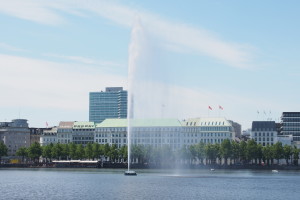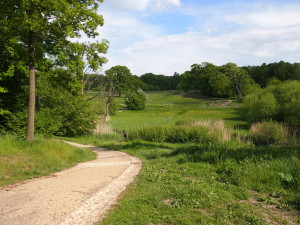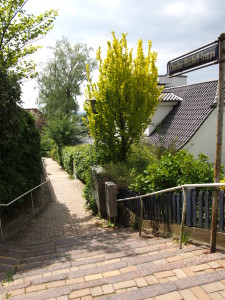 Wednesday, 10.30 a.m. Alster quay 3 of ATG: A lively group of women in their best years disembarks the historic steamer St. Georg. We shortly get to know each other and start our tour with their bus, already awaiting us on Ballindamm. We drive around the Interior Alster in order to see from the „outside“ what was just to be observed from the water. We proceed along the „Glockengießerwall“, Hamburg’s former town wall, to the Mönckebergstraße, the shopping street with the highest turnover of Hamburg. Passing by the magnificient town hall and it’s adjacent stock exchange we reach Hamburg’s oldest railway viaduct at Rödingsmarkt. Turning to our left, Hamburg’s green belt gets into sight. It has been constructed in the old moat. A little sidestep into Hamburg’s Composers‘ Quarter in Peterstraße reveals some historic (reconstructed) buildings of the hanseatic city.
Wednesday, 10.30 a.m. Alster quay 3 of ATG: A lively group of women in their best years disembarks the historic steamer St. Georg. We shortly get to know each other and start our tour with their bus, already awaiting us on Ballindamm. We drive around the Interior Alster in order to see from the „outside“ what was just to be observed from the water. We proceed along the „Glockengießerwall“, Hamburg’s former town wall, to the Mönckebergstraße, the shopping street with the highest turnover of Hamburg. Passing by the magnificient town hall and it’s adjacent stock exchange we reach Hamburg’s oldest railway viaduct at Rödingsmarkt. Turning to our left, Hamburg’s green belt gets into sight. It has been constructed in the old moat. A little sidestep into Hamburg’s Composers‘ Quarter in Peterstraße reveals some historic (reconstructed) buildings of the hanseatic city.
 A short look at Hamburg’s main church St. Michaelis is definitely too short, but we have come to see Blankenese today. Accidentally, our way leads us through Hamburg’s „sinful mile“, the Reeperbahn. A little detour through the Große Freiheit (Great Liberty) lets us understand why this „no man’s land“ between Hamburg and Altona has developed the way it has. But then we finally head westwards and pass St. Pauli’s fish market with big strides. Over the Palmaille, the Elbchaussee – past marvellous villas dating back to a time of incredible prosperity, we reach the foot of Jenischpark, the biggest park at the Elbe. Herrmann, our bus driver, lets us get off here and we are able to stive through the wonderful park until we reach the upper entrance. We have 30 minutes free time which can be used for the two different museums, the greenhouse or the park café. In which order whatsoever.
A short look at Hamburg’s main church St. Michaelis is definitely too short, but we have come to see Blankenese today. Accidentally, our way leads us through Hamburg’s „sinful mile“, the Reeperbahn. A little detour through the Große Freiheit (Great Liberty) lets us understand why this „no man’s land“ between Hamburg and Altona has developed the way it has. But then we finally head westwards and pass St. Pauli’s fish market with big strides. Over the Palmaille, the Elbchaussee – past marvellous villas dating back to a time of incredible prosperity, we reach the foot of Jenischpark, the biggest park at the Elbe. Herrmann, our bus driver, lets us get off here and we are able to stive through the wonderful park until we reach the upper entrance. We have 30 minutes free time which can be used for the two different museums, the greenhouse or the park café. In which order whatsoever.
 After some confusion about how many people we should be, we find our other members at the bus and continue our ride to Blankenese, where we meet another local guide at Hamburg’s oldest railway station. We divide the group into two depending on the number of steps to take – but in the end it turns out that this is not possible in the staircase quarter of Blankenese. One group is guided by Gabriele and one with me. My group visits Goßlers Park, Hesse Park and some staircases. We pass different old and picturesque houses. In between we are always able to pause and enjoy an impressive view over the buildings planted at the slope. But be careful! The stairs are not even and have to be given some extra attention. When we arrive downstairs at the beach, the sun spoils us during a little pause. It is very easy to understand that the „noblesse“ of the society spent their summer days here, went swimming and had their summer houses in this area of Hamburg.
After some confusion about how many people we should be, we find our other members at the bus and continue our ride to Blankenese, where we meet another local guide at Hamburg’s oldest railway station. We divide the group into two depending on the number of steps to take – but in the end it turns out that this is not possible in the staircase quarter of Blankenese. One group is guided by Gabriele and one with me. My group visits Goßlers Park, Hesse Park and some staircases. We pass different old and picturesque houses. In between we are always able to pause and enjoy an impressive view over the buildings planted at the slope. But be careful! The stairs are not even and have to be given some extra attention. When we arrive downstairs at the beach, the sun spoils us during a little pause. It is very easy to understand that the „noblesse“ of the society spent their summer days here, went swimming and had their summer houses in this area of Hamburg.
And finally, after a difficult ascent with around 120 steps and some short poems on Hamburg and its waters, we start the last part of the tour: Café Schuldt invites us with an overwhelming view over the River Elbe and provides us with coffee, tea and cake, which makes all the stresses and strains forgotten. Our way back to Blankenese’s railway station some of our group rely on the „mountain goat“ (bus line 48) and others still on their feet. Back at the railway station, we say good bye and I hope that the „girls“ from Hude will remember the good time in Hamburg!

